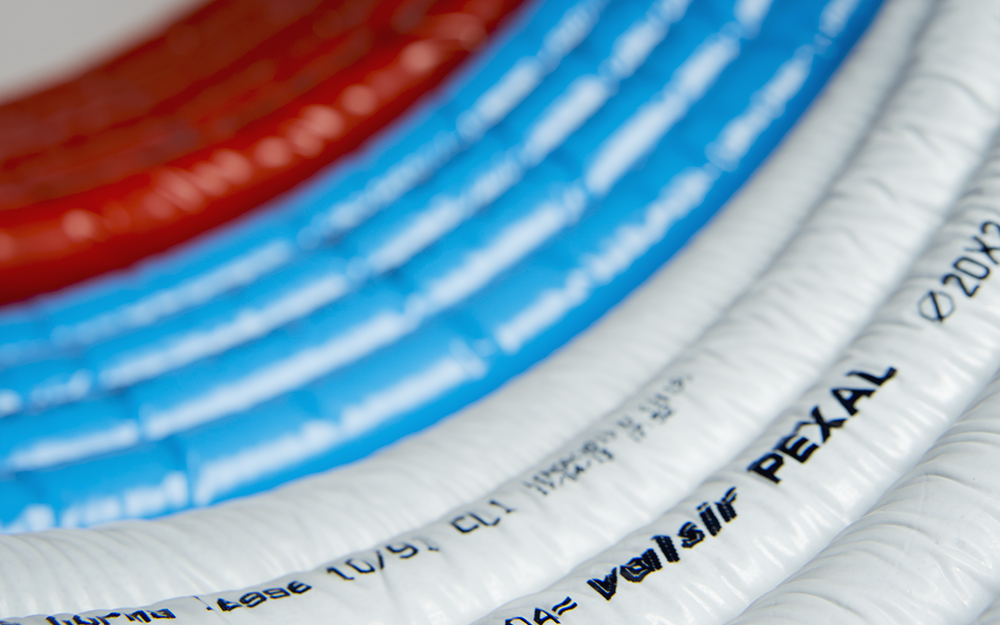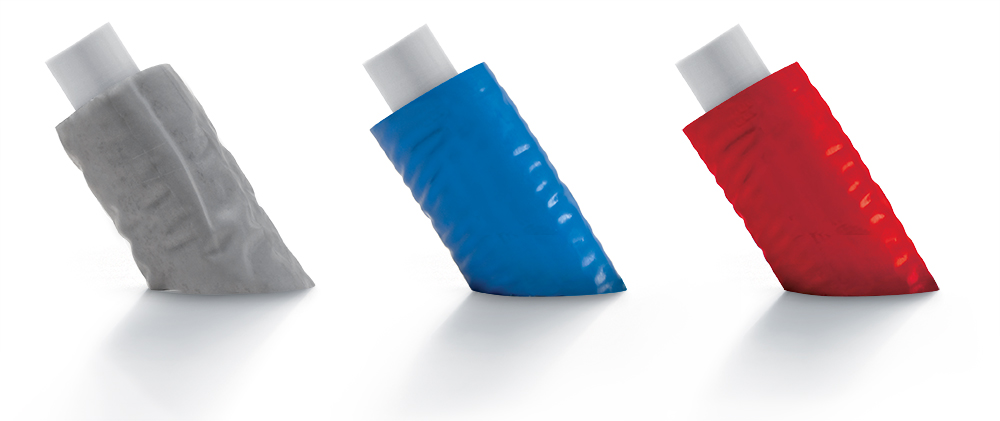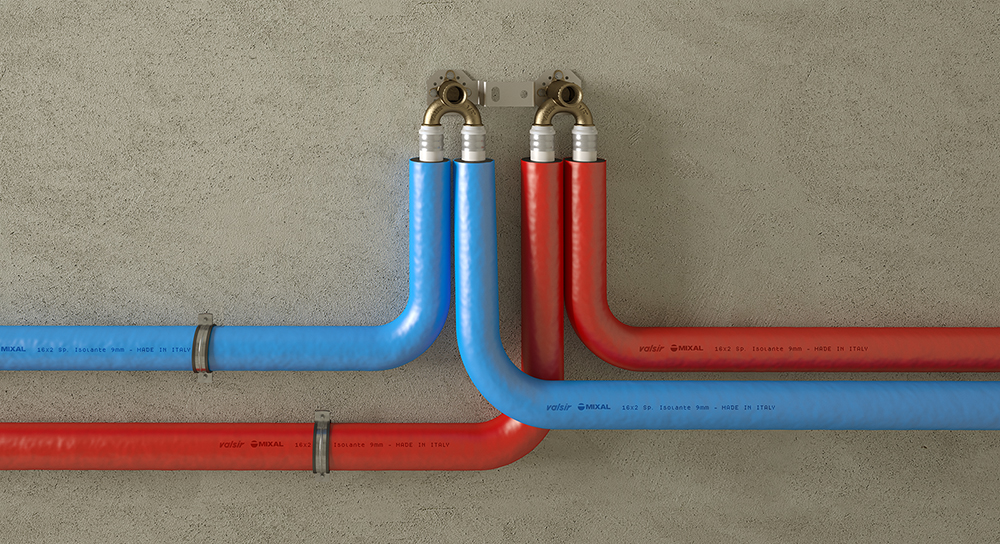The insulated multilayer pipe is a technical variant of the classic multilayer pipe in which the outer coating is equipped with an insulating layer. This coating, often made of expanded polyethylene, has a specific function: to contain heat loss, prevent condensation and protect the pipe from external aggressions.
In modern systems, where energy efficiency regulations are increasingly stringent, insulation is not just a technical option: it is a design requirement.
Structure and function of insulation in pipes
The insulated multilayer pipe is therefore composed of:
- PE-Xb inner layer, hygienic and smooth
- Aluminium intermediate layer, butt-welded
- PE-Xb or PE-HD outer layer
- Insulating sheath
This outer sheath, with an additional protective film, provides thermal insulation for the pipe.
Advantages over non-insulated pipes
- Reduced heat loss
- Prevention of condensation and external corrosion
- Improved overall energy efficiency of the system
- Compliance with regulations on thermal transmittance and sound insulation
Our product range includes various insulated solutions for both the Pexal and Mixal systems, each with specific characteristics designed for professional use in both civil construction and industrial plumbing.

Pexal coated with expanded PE insulation sheath
Pexal is available in a version coated with an expanded polyethylene sheath, which provides effective thermal insulation for the transport of hot and cold sanitary water.
It is particularly suitable for concealed installations.
The pipe can be supplied bare, corrugated or pre-insulated, with a blue (cold water), red (hot water) or grey (both hot and cold) sheath, in thicknesses ranging from 6 to 10 mm.
Mixal with polyethylene sheath
The Mixal pipe, designed for radiant systems and heating circuits, is also available in a polyethylene insulated version.
This configuration is particularly useful for floor or wall installation, where it is important to prevent heat loss to unwanted elements.

In which contexts is it advisable to use insulated multilayer pipes?
Installation in cold environments or subject to condensation
In humid environments or with significant temperature variations, there is a high risk of condensation forming around the pipe. External thermal insulation shifts the dew point and protects both the system and the building structure.
Hot water distribution
In risers and long sections, the use of insulated pipes reduces water temperature loss, ensuring greater system efficiency and user comfort.
How does insulation affect the energy efficiency of systems?
The use of insulated multilayer pipes has a direct impact on the overall energy performance of a water or heating system. In particular, it optimises efficiency, reduces heat loss and improves system response under variable load conditions.
Reduction of heat loss
In domestic hot water distribution systems, heat loss through uninsulated pipes can result in efficiency losses of up to 20%, especially in long sections or in non-air-conditioned environments. The use of an insulated pipe drastically reduces this loss, allowing faster response times when the tap is turned on and lower energy consumption.
Prevention of thermal bridges and condensation
In sections installed near thermally conductive materials – such as concrete, metal or external walls – an insulated pipe limits the creation of thermal bridges. This is particularly important in new low-energy buildings or Class A renovations.
In addition, insulation prevents the formation of surface condensation, which could compromise the integrity of walls, screeds or coatings.

What do the colour codes and coating thicknesses indicate?
The insulating sheath covering the multilayer pipe is not just an insulator: it is also an identifying feature and a design tool.
Blue and red sheaths: a safety feature
In the Pexal and Mixal insulated range, the sheaths are coloured to facilitate circuit identification during installation:
- Blue: pipes for cold water
- Red: pipes for hot water
This visual distinction is essential during installation, testing and maintenance, especially on complex construction sites.
Insulation from 6 to 13 mm: how to choose the right thickness
The insulating sheath can have thicknesses ranging from 6 to 13 mm, depending on the system requirements and local regulations. The greater the thickness, the greater the insulating power.
In exposed sections or in non-air-conditioned environments, it may be advisable to opt for a greater thickness, while in concealed installations inside air-conditioned buildings, thinner solutions can be used.
Insulation in multilayer pipes has several functions, starting with the reduction of heat loss: this means energy savings and lower costs, but also improved performance and longevity of the system.
Insulated multilayer pipes and regulations: what requirements must they meet?
Insulated pipes are not exempt from regulatory requirements. On the contrary, they must meet double requirements: both for the hydraulic part and for the behaviour of the insulating material.
EN ISO 21003 and UNI EN 13501-1
The EN ISO 21003 standard regulates the mechanical, dimensional and performance requirements of multilayer systems. Valsir products fully comply with this standard for all classes of use: domestic water, heating and industrial systems.
With regard to the insulating coating, UNI EN 13501-1 regulates its reaction to fire, which is particularly important in vertical passages and technical rooms. Our insulated pipes are equipped with certified outer films, which guarantee safe behaviour in the event of fire.
Frequently asked questions (FAQ) about insulated multilayer pipes
Can insulated pipes also be used in underground environments?
Yes. If equipped with a protective sheath and of sufficient thickness, insulated pipes are also suitable for underground installation, provided that the insulation and mechanical protection criteria specified in the design are met.
Are insulated pipes more difficult to install?
No. The insulation does not limit the flexibility of the pipe. The insulated Mixal and Pexal versions maintain excellent bendability and allow for quick installation in any context.
How much does energy efficiency improve?
Heat loss can be reduced by up to 30% in long, uninsulated sections. The overall energy improvement depends on the configuration of the system and the environmental conditions.
 Italiano
Italiano
 English
English
 Deutsch
Deutsch
 Français
Français
 Español
Español
 Greek
Greek